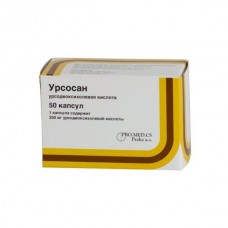Expiration date: 03/2026
The composition and form of issue:
Capsules. 1 capsule contains:
ursodeoxycholic acid 250 mg
auxiliary substances: starch corn starch corn pregelatinized silicon dioxide colloidal magnesium stearate
capsule shell: gelatin titanium dioxide
blistere in 10 PCs in the paper cartons 1, 5 or 10 blisters.
Description pharmaceutical form:
White, hard, opaque gelatin capsules No. 0.
Contents of capsules: white or nearly white powder or white or almost white powder with bits of mass or white or almost white compacted powder, disintegrating under the pressure.
Pharmacokinetics:
Ursodeoxycholic acid (UDCA) is absorbed in the small intestine by passive diffusion (about 90%) and in the ileum by active transport. Cmax is achieved after 1-3 h of ingestion of 50 mg for 30, 60 and 90 min, 3, 8 5, 5 and 3, 7 mmol/l, respectively. The plasma protein binding is up to 96-99%. Penetrates through the placental barrier. The systematic administration of the drug UDCA Ursosan becomes a major bile acid in the serum. Metabolized in the liver (clearance in the primary passing through the liver) taurine and glycine conjugates. The resulting conjugates are secreted into bile. About 50-70% of the total dose is excreted in the bile. A small number nevsosavsheysya UDCA enters the large intestine, where it undergoes cleavage by bacteria (7-dihydroxyflavone) formed litojolevu acid is partly absorbed from the colon, but sulfatides in the liver and rapidly excreted in the form of sulfamethazine or sulfatecontaining conjugate.
Description pharmacological action:
With high polar properties, UDCA is embedded in the membrane of hepatocytes, cholangiocyte and epitheliocyte the digestive tract, stabilizes its structure and protects the cell from the damaging effects of toxic salts of bile acids, thus reducing their cytotoxic effect. Forms a non-toxic mixed micelles with non-polar (toxic) bile acids, which reduces the ability of gastric reluctate to damage cell membranes in biliary reflux-gastritis and reflux-esophagitis. Reducing the concentration and stimulating holert, rich in bicarbonates, UDCA effectively contributes to the resolution of intrahepatic cholestasis. When cholestasis activates Ca2+-dependent alpha-protease and stimulates exocytosis, reduces the concentration of toxic bile acids (henodezoksiholevoy, lithocholic, deoxycholic, etc.), the concentration of which in patients with chronic liver diseases increased.
Competition reduces the absorption of lipophilic bile acids in the intestine, increases their fractional turnover in the enterohepatic circulation, induces holert, stimulates the passage of bile and the excretion of toxic bile acids through the intestines. Reduces the saturation of bile with cholesterol due to inhibition of its absorption in the intestine and suppressing synthesis in the liver and reduce the secretion into the bile increases the solubility of cholesterol in bile, forming with it liquid crystals reduces the lithogenic index of bile increases it concentration of bile acids causes increased gastric and pancreatic secretion, enhances the activity of lipase, has a hypoglycemic effect. Decreases the saturation of bile cholesterol contributes to its mobilization from gallstones, resulting in dissolution (partial or total) cholesterol gallstones and prevent the formation of new stones.
Immunomodulatory effect due to the inhibition of the expression of histocompatibility antigens (HLA-1 on the membranes of hepatocytes and HLA-2 — cholangiocyte), normalization of natural killer activity of lymphocytes, formation of IL-2, a decrease in the number of eosinophils, suppression of the immune Ig in the first place — IgM. Delays the progression of fibrosis. Regulates the process of apoptosis of hepatocytes, cholangiocytes and epithelial cells of the gastrointestinal tract.
Indications:
- uncomplicated cholelithiasis: biliary sludge dissolving cholesterol gallstones in a functioning gallbladder prevention of recurrence of stone formation after cholecystectomy
- chronic hepatitis of various Genesis (toxic, drug, etc.)
- cholestatic liver diseases of different Genesis, including primary biliary cirrhosis, primary sclerosing cholangitis, cystic fibrosis (cystic fibrosis)
- non-alcoholic fatty liver disease, including nonalcoholic steatohepatitis
- alcoholic liver disease
- viral hepatitis chronic
- biliary dyskinesia
- biliary reflux-gastritis and reflux-esophagitis.
Contraindications:
- hypersensitivity
- roentgenologically (high in calcium) gallstones
- nonfunctioning gallbladder
- expressed by the human kidney, liver, pancreas
- liver cirrhosis in the decompensation stage
- acute infectious-inflammatory diseases of the biliary tract.
UDCA has no age limits, but children under 3 years are not recommended to use the drug in this dosage form.
Application of pregnancy and breast-feeding:
The use of UDCA during pregnancy is possible only in the case when expected benefit for mother exceeds the potential risk to the fetus. Data on the allocation of UDCA in breast milk are not currently available. If necessary, the use of UDCA in the lactation period should solve the issue of termination of breastfeeding.
Side effects:
Diarrhea (can be dose-dependent).
Rarely calcining gallstones, transient (transient) increase in liver transaminases, nausea, vomiting, abdominal pain, allergic reactions.
Drug interactions:
Antacids containing aluminum and ion-exchange resins (cholestyramine), reduce the absorption. Lipid-lowering drugs (especially clofibrate), estrogens, neomycin, progestins, or increase the saturation of bile with cholesterol and may reduce the ability to dissolve cholesterol gall stones.
Method of application and dose:
Inside, squeezed small amounts of water.
For dissolution of cholesterol gall stones of average daily dose — 10-15 mg/kg the Course of treatment is 6-12 months or more to completely dissolve the stones. In gallstone disease the entire daily dose is taken as a single dose at night.
For the prevention of recurrent stone formation is recommended to use the drug for several months after dissolution of stones.
After cholecystectomy for prevention of repeated cholelithiasis is 250 mg 2 times a day for several months.
In chronic hepatitis of various Genesis (toxic, drug, etc.), chronic viral hepatitis, nonalcoholic fatty liver disease, including nonalcoholic steatohepatitis, alcoholic liver disease average daily dose of 10-15 mg/kg 2-3 admission. The duration of therapy is 6-12 months or more.
In cholestatic liver diseases of different Genesis, including primary biliary cirrhosis, primary sklerosiruuschem cholangitis, cystic fibrosis (cystic fibrosis), the average daily dose is 12-15 mg/kg if necessary, the average daily dose may be increased to 20-30 mg/kg in 2-3 doses. The duration of therapy from 6 months to several years.
When biliary dyskinesia in hypokinetic type the average daily dose of 10 mg/kg in 2 divided doses for 2 weeks to 2 months. If necessary, the treatment course should be repeated.
In biliary reflux-gastritis and reflux-esophagitis — 250 mg/day before bedtime. The course of treatment — from 10-14 days to 6 months, if necessary — up to 2 years.
Overdose:
The cases of drug overdose are unknown.
Special instructions:
While taking the drug with the purpose of dissolving gallstones, you must meet the following conditions: the stones must be cholesterol (roentgen), their size should not exceed 15-20 mm, the gallbladder need to remain functioning and be filled with stones not more than half, the patency of the cystic and common bile duct should be preserved. Prolonged (more than 1 month) taking the drug every 4 weeks during the first 3 months of treatment, and thereafter every 3 months should be carried out the biochemical analysis of blood to determine liver transaminases. Control of treatment efficiency should be performed every 6 months according to the ultrasound of the biliary tract. After full dissolution of stones is recommended to continue the drug for at least 3 months, in order to facilitate the dissolution of the remnants of stones whose dimensions are too small for their detection, and prevention of recurrence of stone formation.




